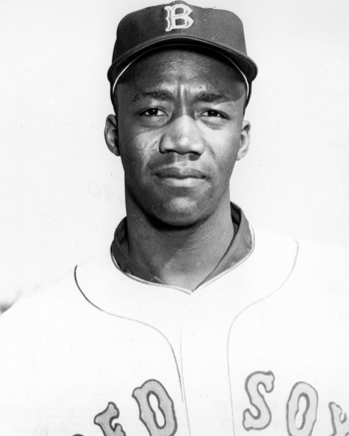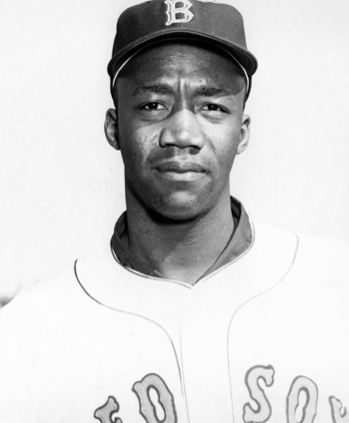June 16, 1958: Ted Williams, Pumpsie Green star in Red Sox exhibition at Minneapolis
 The Minneapolis Millers of the American Association were the Triple-A minor-league affiliate of the Boston Red Sox for two stretches, 1937-38 and 1958-60.1 Ted Williams had won the Triple Crown for the Millers in 1938 and, as it happens, “The Kid” was with the Boston Red Sox from 1939 through 1960, including this game in 1958 when the Red Sox visited Bloomington for a midseason exhibition game.2 When the Minnesota Twins became a major-league franchise in 1961, the Millers ceased operations.
The Minneapolis Millers of the American Association were the Triple-A minor-league affiliate of the Boston Red Sox for two stretches, 1937-38 and 1958-60.1 Ted Williams had won the Triple Crown for the Millers in 1938 and, as it happens, “The Kid” was with the Boston Red Sox from 1939 through 1960, including this game in 1958 when the Red Sox visited Bloomington for a midseason exhibition game.2 When the Minnesota Twins became a major-league franchise in 1961, the Millers ceased operations.
In 1958 the Red Sox were nearing the end of a decade of mediocrity. They always had a couple of star players, Williams foremost among them, but after the 1950 season, they didn’t contend for a pennant again until 1967. Only in 1951 did they finish less than a dozen games out of first place. The 1958 season was one of their better ones: They had a winning record at season’s end (79-75, 13 games out of first place). The team had yet to field an African-American player. In 1959 Elijah “Pumpsie” Green became the first African American to play for the big-league Red Sox.
On June 15, the Sox had lost both halves of a Sunday home doubleheader to the Kansas City Athletics, 16-7 and 9-4. They were in second place, though, with a 30-28 record and were seven games behind the New York Yankees.3
Into the 1990s, the Red Sox typically played one in-season exhibition game each year against their top affiliate in the minors.4
They left Boston for Chicago to play the White Sox on Tuesday, June 17, playing the Millers on Monday night. It was a quick visit. Within an hour after the game, they were off to Chicago. But the game was a very eventful one, with 24 runs scored, a Millers win, and some memorable moments.
The game drew very well, bringing 18,368 fans to the ballpark. They didn’t have to wait long for what many hoped most to see. Pitching for the Millers was left-hander Jack Spring. With one out, Pete Runnels singled. Ted Williams took his stance in the batter’s box – facing the “Williams shift.” Spring missed the plate three times in succession; with a 3-and-0 count, he put the next one over and Williams hit it well – a “cloud-scraping” blow over the “small regiment of kids waiting beyond the right field screen.”5 They played him too shallow, said the Associated Press feed. “Ted’s smash dropped near an asphalt runway beyond the fence.”6 It was hit a roughly estimated 410 feet. The fence was at 355 feet, but it passed that and reached a light tower 55 feet beyond that.7
Before the top of the first was done, the Red Sox had scored five runs off Spring. Dick Gernert singled and Gene Stephens drew a walk. Sammy White then doubled in one run, another scoring on a throwing error. Jimmy Piersall singled in the fifth run.
Millers manager Gene Mauch, a teammate of Ted’s from 1956 and 1957, must have assumed this would be par for the course. Managing the Red Sox was Pinky Higgins.
Starting for the Red Sox was Bob “Riverboat” Smith. The southpaw worked the first six innings of the game, not allowing a run through the first four. Al Schroll had replaced Spring after a scoreless second. Neither team scored in the second, third, or fourth. In the bottom of the fifth, the Millers scored twice on Frank Kellert’s single and a home run by Tommy Umphlett over the screen in left field. Schroll allowed only one hit in the four innings he pitched against the big leaguers.
And in the bottom of the sixth, Smith was banged around for six more runs, the biggest blow a two-out, first-pitch bases-clearing triple by Pumpsie Green, batting right-handed against Smith. It gave the Millers an 8-5 lead. Green’s triple to center field was reported at 400 feet.8
With Tom Borland on the mound for the Millers, Boston responded with four runs in the top of the seventh, all thanks to a grand slam over the low right-field fence by first baseman Marty Keough, who had taken over for Dick Gernert. This gave Boston the lead, 9-8.
The lead didn’t last long. Right-hander Willard Nixon pitched the seventh and eighth for the Red Sox, allowing six runs in the seventh to match the six-run sixth. A throw to Keough intended to nab Lu Clinton went astray and Clinton made it to third base on the error. With one out, both Kellett and Umphlett drew walks. Harry Malmberg singled to tie the game, 9-9. The pitcher, Borland, then singled, driving in two more. Eddie Sadowski singled for the 12th run, and Green (batting from the left side of the plate) singled for the 13th (and his fourth RBI). The 14th run scooted in on a fielder’s choice grounder hit by Jose Valdivielso.
Now it was 14-9 in favor of the Millers.
Stephens singled and Nixon doubled in the top of the eighth, the Red Sox picking up their 10th but final run of the game.
Nixon held the Millers scoreless in the eighth but didn’t have to pitch the ninth. With the 14-10 lead, the Millers had already won the game. Borland got the win; Nixon bore the loss. Despite the 24 runs, 24 hits, and six bases on balls, the game lasted 2:24.
For “the usually weak-hitting Millers,” the 14 runs matched their high for the year.9
Neither Jackie Jensen nor Frank Malzone played in the game. Because neither liked to fly, they received dispensation to take the train from Boston to Chicago.10 The Boston Traveler reported that Williams enjoyed catching up with old friends, residents of the area that he had not seen for years.11
Sources
In addition to the sources cited in the Notes, the author consulted Baseball-Reference.com.
Notes
1 For a very detailed history of the Millers, see stewthornley.net/millers.html. Stew Thornley points out that the “1930s connection between the Red Sox and Millers was a looser affiliation than the one from 1958-60, when the Millers were a full-fledged farm team.” Email to author on August 26, 2019.
2 Williams had played in the Millers’ home ballparks: Nicollet Park in 1938, and in Metropolitan Stadium for this 1958 game.
3 The standings were tightly bunched. Eighth-place Baltimore was only four games behind the Red Sox, 11 GB.
4 In earlier times, it was not uncommon to play a number of exhibition games during the season. In 1934, for instance, the Red Sox played nine such games against various teams, one of which was the company team from Burnham & Morrill, the canner of B&M Baked Beans in Portland, Maine. During the 1990s, they played seven such games. The last “normal” in-season exhibition game was in 1999 against the Pawtucket Red Sox. All told, the Red Sox’ record for in-season exhibition games is 142-86-9. The Red Sox had played spring-training exhibition games against the Millers as early as 1922 (four games, all played in Tennessee) and one in Alabama in 1927. The Millers won two of those five games. This 1958 game was the first Millers-Red Sox game since the 12-9 win for the Millers in 1927.
5 Associated Press, “Ted Homers but Millers Beat Red Sox,” Fergus Falls (Minnesota) Daily Journal, June 17, 1958: 8.
6 “Ted Homers.”
7 Roger Birtwell, “Pumpsie and Ted Both Star,” Boston Globe, June 17, 1958: 25, 27.
8 Riger Birtwell, “Pumpsie Looks Good as Hitter,” Boston Globe, June 18, 1958: 42.
9 The phrase and the most complete account of the game are thanks to Tom Briere, “Millers Beat Boston 14-10 as Ted Thrills 18,638,” Minneapolis Morning Tribune, June 17, 1958: 12.
10 “Keough No Threat at First Base,” Boston Traveler, June 17, 1958: 49.
11 “Keough No Threat.”
Additional Stats
Minneapolis Millers 14
Boston Red Sox 10
Metropolitan Stadium
Bloomington, MN
Corrections? Additions?
If you can help us improve this game story, contact us.


